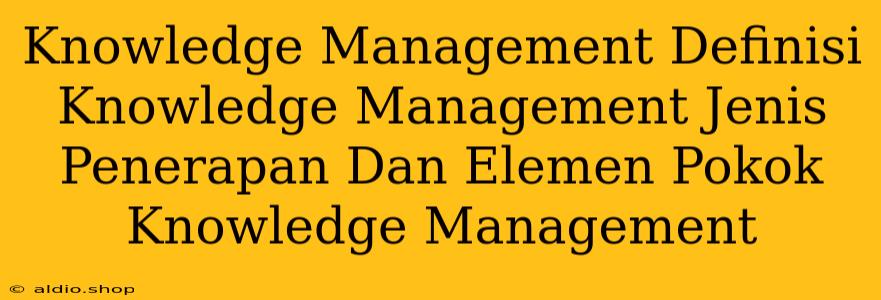Knowledge management (KM) has emerged as an essential practice in organizations that seek to optimize their information and knowledge assets. This article aims to provide a comprehensive overview of knowledge management, its definitions, types of applications, and its key elements.
What is Knowledge Management?
Knowledge management refers to a systematic approach that organizations utilize to identify, create, represent, distribute, and enable the adoption of insights and experiences.
The Importance of Knowledge Management
In today's fast-paced world, knowledge is a critical resource. Effective KM can lead to improved efficiency, innovation, and competitive advantage. By managing knowledge effectively, organizations can:
- Enhance Decision Making: Access to comprehensive and accurate knowledge leads to better informed decisions.
- Improve Organizational Learning: KM supports continuous learning and development across the organization.
- Boost Productivity: Streamlining knowledge sharing reduces redundant work and accelerates project timelines.
Definitions of Knowledge Management
The concept of knowledge management varies among different scholars and practitioners. Here are a few widely accepted definitions:
- Theoretical Perspective: According to Nonaka and Takeuchi (1995), KM is a process of converting tacit knowledge into explicit knowledge.
- Practical View: The American Productivity & Quality Center (APQC) defines KM as the "systematic management of knowledge assets to help organizations achieve their objectives."
- Holistic Approach: Davenport and Prusak (1998) describe KM as the process of capturing, distributing, and effectively using knowledge.
Types of Knowledge Management Applications
Knowledge management can be applied in various ways across different sectors. Here are some key applications:
1. Knowledge Repositories
These are databases or systems where knowledge is stored for easy retrieval. They may contain documents, manuals, reports, and case studies.
2. Communities of Practice
These are groups of individuals who share a common interest or profession, collaborating to exchange knowledge and solve problems collectively.
3. Knowledge Mapping
This involves visualizing the flow of knowledge within an organization, helping to identify gaps and opportunities for improvement.
4. Learning Management Systems (LMS)
LMS are technological platforms designed to deliver and manage training programs, ensuring knowledge dissemination across the organization.
5. Best Practices Sharing
Organizations often create platforms or forums for sharing successful strategies and approaches, enhancing collective organizational knowledge.
Core Elements of Knowledge Management
To effectively implement knowledge management, organizations should focus on several core elements:
1. People
The most crucial element of KM is the people involved. Encouraging a culture of sharing and continuous learning is essential for effective KM.
2. Processes
Well-defined processes are vital for capturing, storing, and sharing knowledge. These processes ensure that knowledge flows seamlessly throughout the organization.
3. Technology
Modern KM relies heavily on technology, including databases, collaborative tools, and analytics platforms. Technology acts as a backbone for capturing and disseminating knowledge.
4. Content
The knowledge itself is also a key element. Organizations need to curate content effectively to ensure its relevance and accessibility.
5. Culture
A supportive organizational culture that values knowledge sharing and collaboration fosters an environment conducive to effective KM.
Detailed Table Breakdown of Knowledge Management
Here is a breakdown of the key aspects of knowledge management in tabular format:
| Element | Description | Importance |
|---|---|---|
| People | Individuals who create, share, and utilize knowledge. | Essential for fostering collaboration. |
| Processes | Procedures for capturing, storing, and sharing knowledge. | Ensures efficiency and consistency. |
| Technology | Tools and platforms used in KM. | Enhances knowledge accessibility. |
| Content | The actual knowledge assets. | Critical for organizational learning. |
| Culture | The organizational environment promoting KM. | Influences knowledge sharing behaviors. |
Conclusion
Knowledge management is a multifaceted practice that holds significant potential for enhancing organizational performance. By understanding its definitions, applications, and core elements, organizations can strategically harness knowledge as a valuable asset. In an era where knowledge is power, effective KM can position organizations for sustained success and innovation.
In conclusion, as we venture into 2024, businesses that prioritize knowledge management will not only enhance their internal processes but will also adapt better to the evolving market demands. Investing in KM today can pave the way for greater achievements tomorrow.
